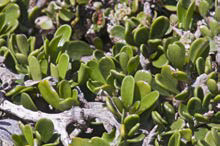Trip Report – 2 May 2015: Airways Corporation land & Rangitatau Reserve, Strathmore, Wellington
The approach to the reserve is on Airways Corporation land, along a WW2 road, which leads south from the end of Ahuriri St, Strathmore, before it turns at a WWII radar station, to run north. We spent considerable time botanising along and near the road on this land, before we reached Rangitatau Reserve proper.
BotSoc last visited this area on 5 October 2002, on a weeding trip led by Julia White. Our 2 May trip we prepared a plant list from scratch, a good exercise for all of us. Walking south, we saw some
Asplenium appendiculatum subsp.
maritimum hanging over the road cutting, then several
Melicytus crassifolius / thick-leaved mahoe, and as we continued north, many more of them. This Airways Corporation site is indeed a stronghold of this species, whose national Conservation Status is ‘Declining’.
 |
Melicytus crassifolius. Photo: Jeremy Rolfe.
|
Above the road cutting are numerous
Cotyledon orbiculata / pig’s ear, listed in the National Pest Plant Accord. The next native plants of great interest were on a knob east of the road: several matagouri / Discaria toumatou, on the only known site in Wellington city, amongst NZ daphne /
Pimelea prostrata, up to 70 cm tall, some in flower, and a lone patotara /
Leucopogon fraseri. Hunkered down in the wind-swept vegetation, we sheltered from the breeze, enjoying all-round views and morning tea, before returning to the old road.
Beyond Birkhall Grove, and Bowes Crescent, we rejoined the old road and entered Rangitatau Reserve, with a fine view over the largely indigenous coastal forest down the valley of ‘Te Poti Stream’ to Tarakena Bay. Before continuing down valley, we lunched on a grassy slope, then scoured the bush edge for plants to add to our list. We hope that the sole, large pine will be removed before its progeny begin to establish in the bush.
A highly informative panel pictured and described the site of Rangitatau, an historic, palisaded Ngai Tara pa, on the western headland of Tarakena Bay, later occupied by Ngati Ira, and destroyed by raiders from the north in 1819 –20, along with the associated, stockaded village, Poito, in the lower valley.
The ascent of the ‘sand track’ led us through coastal forest, including huge, gnarled, twisted, old taupata trees. We also found planted pohutukawa, (including a hybrid),
Piper excelsum subsp.
peltatum, makamaka /
Ackama rosifolia, a Far North endemic, and
Corokia cheesemanii. During the day, we recorded 73 indigenous species, 19 of which were planted, including some species which do not occur naturally in Cook Strait Ecological District 39.02, and 86 adventive species. Just as with Centennial Reserve reported on earlier in this newsletter, we wonder how these plantings will affect the ecological integrity of the reserve in the long-term, when they start to produce viable seed, and disturb the natural process of forest recovery. How will ecologists, botanists and the managers of the land, deal with this situation?
Participants: Sam Buckley, Eleanor Burton, Gavin Dench, Michele Dickson, Jane Humble, Rodney Lewington, Winifred Maindonald, Ann Mitcalfe, Chris Moore, Leon Perrie, Darea Sherratt, Sunita Singh, co-leaders / scribes: Chris Horne and Barbara Mitcalfe.

 Site Index
Site Index







 Site Index
Site Index





